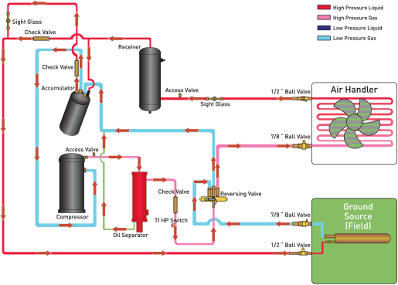Build it Back Greenbushfires
Ground-Sourced Heat Pumps
 Relatively
unknown in Australia, ground-source heat pumps are one way to
reduce the amount of energy used in cooling and heating while still
maintaining a comfortable home.
Relatively
unknown in Australia, ground-source heat pumps are one way to
reduce the amount of energy used in cooling and heating while still
maintaining a comfortable home.
Heat pumps are not a new technology and most households already have one-the fridge.
The pipes at the back are hot compared to the inside of the fridge, as these pipes emit heat removed from inside.
Usually heat moves from the hotter area to the cooler area but a heat pump reverses this direction.
Ground-source heat pumps transfer heat between the house and the ground. They make use of the fact that the temperature some metres below the surface is fairly constant over the whole year, varying between 10°C and 15°C. On a very hot day when the outside temperature is 40°C and the desired room temperature is 22°C, the reverse-cycle air-conditioner needs to provide at least an 18°C temperature difference between the condenser and the evaporator, while the ground-source heat pump only needs to provide a temperature difference of 7°C. This is easier to achieve and less energy is required.
Setting up a ground-source heat pump takes a bit of work because pipes have to be buried underground. When choosing horizontal systems, the pipes are laid up to 1.8 metres deep and a large area of ground is required. The other option is to drill several holes straight down to a depth of at least 80 metres. This is the most expensive method but uses only a comparatively small area. If there is some sort of water body available, such as a dam, pond, river or the ocean, this can also be used, but the pipes have to be covered by at least three metres of water.
The performance of heat pumps is measured by the coefficient of performance (COP). This is the ratio of the energy of the heat being moved to the electricity consumed. A modern reverse-cycle air-conditioner has a COP of three or so (which means that 1kWh of electricity moves 3kWh of heat) while ground-source heat pumps can achieve COPs of more than six.
However there are some problems with ground-sourced heat pumps. First of all there are not too many distributors of ground-source heat pumps in Australia. Unlike in other countries, especially Sweden, the ground-source heat pump is underdeveloped here and mainly confined to commercial buildings. Also, most systems that are currently available are too big for houses in built-up areas, especially when the residents have already tried their best to reduce their air-conditioning requirements by using exterior blinds, cross ventilation and other energy-efficiency measures. However, the currently available ground-source heat pumps would suit an apartment complex, the shared use of more than one house, or could be applied in a commercial or industrial environment quite well.
The most critical point at the moment is the price to install them. They are expensive and can be considered to be the Porsche of the air-conditioner world. Good technology has its price-they cost about four times what a conventional system would cost. The drilling adds about $10,000 to the cost above and beyond conventional air conditioning, but pays for itself in five to ten years depending on usage.
Suppliers
Earth to Air Solutions - www.earthtoair.com.au
Ph. 1300 780 216
Geoexchange - www.geoexchange.com.au
Ph. 02 8404 4193
- More Info
- > ReNew magazine
Listed suppliers are a guide and are not endorsed by Green Cross Australia or the Alternative Technology Association.




